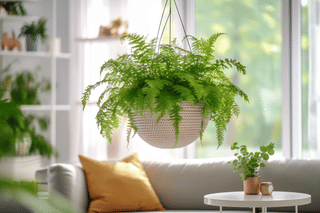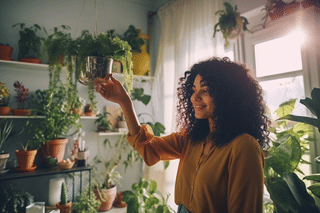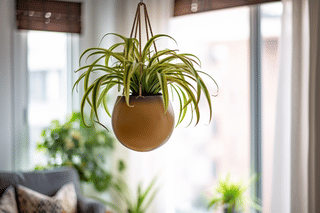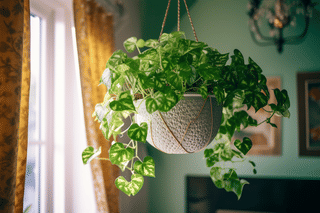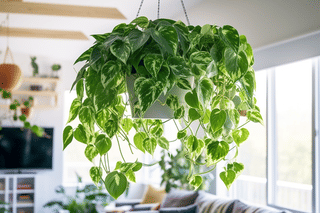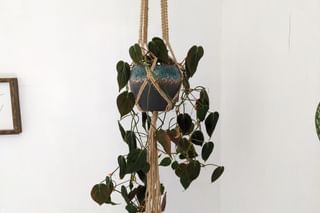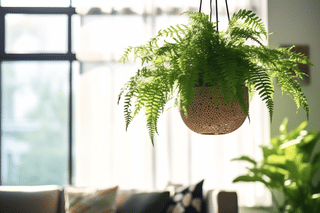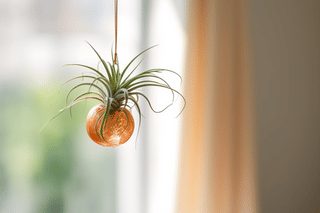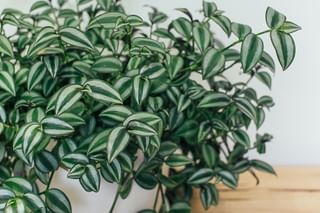The 7 best hanging plants for beginners
Looking to bring some life to your home with beginner-friendly hanging plants? This comprehensive guide covers 7 of the best options, along with easy tips and tricks for keeping them healthy and thriving. Say goodbye to brown thumbs and hello to lush greenery in every corner of your space!
Ever looked around your room and felt that something was missing? Hanging plants may just be the answer you're looking for!
Hanging plants bring a unique look to any room. They create a calming indoor jungle that not only looks great but also helps you breathe better. The best part is, you don't need a green thumb to get started!
In this easy-to-follow plant care guide, we'll explore the 7 best beginner-friendly hanging plants. I'll guide you on how to choose a hanging plant that fits your lifestyle, how to correctly care for them, and why they are perfect for plant parents of any skill level.
These are the topics we're going to look at in this plant care guide:
Are you ready to transform your house into an indoor jungle? Let's dive into this plant care guide to discover the hanging plants that are perfect for any plant owner! Let's get started!
What are Hanging Plants?
Hanging plants! The category makes it sound easy, right? They're exactly what the name suggests: adorable potted plants that you can hang up from your ceilings, walls, shelves, and more. Not just vining plants work well as hanging plants, but any plant that naturally droops a little, like a fern, is a great option to become a hanging plant.
Hanging plants brighten a corner instantly. They add a bit of color and a bit of texture to even the most boring places. They are also a great way to bring nature indoors.
Why hanging plants are perfect for beginners
So why are hanging plants great plants for beginning plant owners? Let's look at some of the features of hanging plants that make them specifically great for beginning plant owners.
- Minimal Care: Most hanging plants are quite forgiving. Even if you forget to water them once in a while, they'll be just fine.
- Perfect for small spaces: Short on floor space? No problem. Hanging plants don't need any floor space, just a free spot in the air.
- Easy Propagation: Many hanging houseplants can be easily propagated. This is not a specific feature of hanging plants, but just a nice coincidence.
- Pest Resistant: Because the plants are hanging off the ground, it helps to keep your plant safe from many ground-crawling pests.
These features make hanging plants great plants for beginning plant owners, as there is not a lot that can go wrong. This helps you, as a beginner, to gain confidence in taking care of plants.
Advantages of hanging plants in your home
So if you're not yet convinced hanging plants are right for you, let's have a look at some of the advantages of hanging plants!
Hanging plants in your home is not only a cool way to decorate but it also has benefits for both your health and mood. Let's take a closer look at why you should consider adding some hanging plants to your living space.
Air Quality Improvement
Did you know that plants can act like little eco-friendly cleaners for the air inside your home? One big advantage of hanging plants is their ability to improve air quality. Plants are nature's best air purifiers. They take in carbon dioxide and release oxygen, which we all need to breathe. Not only that, but they can also filter out harmful toxins in the air.
Psychological and Emotional Benefits
Hanging plants in your home can also do wonders for your mental and emotional well-being. Numerous studies have shown that being around plants can significantly lower levels of tension, anxiety, and feelings of fatigue. This instinct to connect with nature, also known as "biophilia", can help create a calming and relaxing environment in your home.
Home Décor Upscale
But the benefits of hanging plants don't just stop at physical and mental health. They can also add a classy and trendy vibe to your home décor.
With so many different hanging plant species and gorgeous planter options, you can easily find a plant that perfectly fits your personality and living space. Whether you like a modern/minimalist or textured plant, there's a hanging plant out there to upgrade your living spaces.
How do you care for your hanging plants?
Taking care of your hanging plants is just as simple and exciting as decorating your home with them. You just have to understand their basic needs and provide a good space for them to thrive. Let's go through a few important aspects: ideal temperature, light requirements, and watering tips.
Ideal temperature for hanging plants
Different plants have different temperature requirements, but generally, indoor hanging plants prefer temperatures between 60-75℉. For any plant, but especially hanging plants, it's important to keep them out of cold or hot drafts, like near air conditioners or heaters. These drafts cause large temperature changes, which can dry out and stress your plant.
How much light do hanging plants need?
Like all plants, hanging plants need light to grow. However, the amount of light required varies from plant to plant. Some plants love direct sunlight, while others prefer indirect light or some shade. It's important to check what kind of light is best for your specific plant. A good rule of thumb is to place most hanging plants in a bright, well-lit corner, but out of direct sunlight.
If you're placing your hanging plant near a window, make sure to reserve a little space for a curtain, as you might need to protect your plant from the harsh sun in the summer.
Watering tips for your hanging plants
Now the toughest part of taking care of hanging plants: watering. The most important thing to remember is to always check the soil before watering your plants. When the top inch of soil is dry, it's the right time to water your plant.
Overwatering can cause root rot, which is harmful to most plants. Always let the excess water drain out from the pot's openings to avoid making the roots too soggy. Remember, it's not just about how much you water, but also how well your plant's soil drains.
If your hanging plant doesn't have a drainage hole, you have 2 options: use an inner pot with a drainage hole and an out pot without holes or experiment with how much water you should give your plant. I recommend you use an inner pot and lift that out of the outer pot to water your plant, but I've also had success with experimenting with how much water my plant needs.
Perfect beginner-friendly hanging plants to start with
Now that we have a good idea of how to take care of houseplants that grow in hanging planters, let's have a look at the 7 easiest hanging houseplants. These houseplants are very beginner-friendly because they don't have any complicated requirements and they also grow quite quickly. This is perfect for beginning plant owners, as you'll quickly gain the confidence to take care of plants.
Let's look at 7 easy-to-care-for hanging houseplants!
Spider Plant
Are you looking for an easy-to-care-for plant? The Spider Plant might just be perfect for you! It has stripes that make it stand out from the crowd, and won't make it mad if you forget to water it.
As a beginner, it's great because its forgiving nature can help you learn more about taking care of plants. The best part is that even if you slip up and forget to give your plant what it needs now and then, it's not going to give up on you!
The spider plant can recover from mistakes quite quickly and has explosive growth in the spring and summer.
Read more about taking care of a Spider plant in How to care for a spider plant.
English Ivy
English Ivy is an evergreen plant that will keep your home looking fresh and classy. It's a great choice for decoration since it can thrive even in dimly lit areas or homes with limited natural light.
For healthier growth, this beautiful plant likes a weekly shower which will keep its leaves shiny and dust-free. With its adaptable qualities and timeless appeal, there's no doubt that an English Ivy in your home would certainly add style.
This plant is perfect for those that tend to overwater their plants. This plant loves moisture and prefers to grow in soil that's moist (not wet) most of the time.\
Read more about taking care of an English ivy in How to take care of an English Ivy.
Golden Pothos (Epipremnum aureum)
If you're starting your journey with indoor gardening, Golden Pothos is a great choice for you! It may look beautiful and delicate, but this plant is strong and hardy. It has shiny leaves shaped like hearts which add some texture to your living space! The only thing Golden Pothos needs is just enough watering when its soil feels dry.
The Golden Pothos is very forgiving when it comes to sunlight and thrives in quite a large variety of sunlight exposure. They like medium to bright indirect sunlight and can even survive in low-light places.
One of my favorite features of the Epipremnum aureum is that it's very easy to propagate. The vines are full of moisture, so cuttings can quite easily grow roots in a few weeks.
Read more about taking care of a Golden Pothos in How to care for a Golden Pothos.
Philodendron Micans
Philodendron Micans is an amazing plant! It's easy to keep, no matter where you live or how much natural light it gets. It thrives in either bright or medium-lit conditions and only needs watering once the top inch of soil has dried. If you want to help it stay healthy and thriving, fertilize it every once in a while!
The velvety texture on the leaves of this plant is truly something different. It adds new colors and textures to your hanging plant that will almost make it look like the plant is not real. It's also quite a fast-growing plant, so you'll see new leaves pop up quite often.
Read more about taking care of a Philodendron in How to care for a Philodendron.
Boston Ferns
Boston Ferns are a classic choice for a hanging planter. With their feathery leaves sprouting off the plant in multiple directions like a firework, they will bring some new life into your home. They also come with one small bonus: simplicity.
Boston Ferns thrive best within cool, humid environments, meaning that just a bit of misting each week will be exactly what this hanging houseplant craves! The Boston fern thrives in moist soil and is a great choice for this that tend to overwater their plants, much like the English Ivy.
Read more about taking care of a Fern in How to take care of a Fern indoors.
Air Plants
Air Plants offer something spot-on for all those of you looking to add a unique plant to your home. They don't need soil to grow like other plants, instead, they absorb water and nutrients from the air! This sets them apart and makes them stand out. Not only that but tending to them isn't complex either. A water bath every one or two weeks is all you have to do to help them thrive!
Air plants have a special way of being suspended. You can hang them upside down to show off their foliage or you can choose to suspend them with thin wire so that the foliage hangs down like a curtain.
Read more about taking care of an Air plant in Air plant care: a comprehensive guide for beginners.
Tradescantia zebrina
Adding a Tradescantia zebrina to your collection is the perfect way to bring a new color to your home! Its purple leaves are a real attention grabber and add a variation to your other (green) plants.
To help keep this plant healthy, place it in an area with indirect sunlight, otherwise it can, unfortunately, become a bit leaf-scorched! To keep it happy, make sure not to forget to water it regularly, because it likes the lightly moist soil at all times.
Read more about taking care of a Tradescantia Zebrina in How to care for a Tradescantia zebrina.
Solutions to common hanging plant's problems
Even if you do everything right, your hanging plants might still have to deal with some issues. Two of the most common problems are yellowing leaves and pest invasion. In this section, we'll look at diagnosing and treating these issues, to help keep your plants healthy.
Why are my hanging plant's leaves yellowing?
If your hanging plants' leaves are turning yellow, don't panic! It's a common issue and in most cases, easy to solve. Yellowing leaves are usually a sign of two conditions: overwatering or inadequate light.
Overwatering: Plants breathe through their roots and if they're constantly damp, the roots can suffocate and start to rot. The result is the dull, yellow leaves you see. Moderation is key! Always let the top soil dry out before watering again.
Lack of light: Hanging plants love natural light and not getting enough can cause them to turn yellow. Try moving your plant to a brighter location, but keep them away from direct, harsh sunlight as it can scorch the leaves.
How to deal with a pest invasion
Just when you thought you'd figured out plant care, pests get to your plants. But don't worry too much, dealing with pests is easier than you'd think.
Identify the culprit: Check your plant thoroughly. Small bugs like aphids, spider mites, or whiteflies could be feasting on your plant. They're usually found on the underside of the leaves.
Natural pest control: Mixing a small amount of dish soap with water and spraying it on your plant every few days can help deal with these pests.
Neem oil: If the infestation is more serious, you might want to consider using Neem oil. It's natural and safe for most plants. Just add a few drops to a spray bottle with water and spray your plant liberally.
Remember, it's crucial to act swiftly at the first sign of a problem. By taking immediate steps, you can minimize plant damage and give your hanging plants the best chance of bouncing back to health.
Thank you for reading this post! I hope it helps you to keep your plants healthy and beautiful! If you're looking for more guides on specific plants, you can always request a plant guide to get a guide for the plant you have trouble with.
Test your plant care knowledge
Quiz completed!
Want to learn more? Sign up for my newsletter to receive free tips in your inbox!
Sign up now!